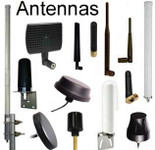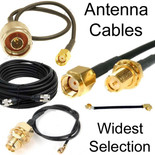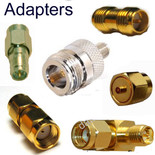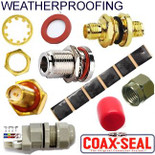Antennas, Antenna Cables, Wireless Products: Technical Articles
Sheathing of Antenna Cables: Signal Performance & Durability
Table of Contents
- 1. What the Sheathing (Outer Jacket) Does
- 2. Common Coaxial Sheathing Materials
- 3. Typical Sheath for Popular Coax Families
- 4. Outdoor and UV Considerations
- 5. Mobile / Rugged / IoT Applications
- 6. Indoor vs. Outdoor Recommendations
- 7. Special Features to Look For
- 8. Summary Table: Sheath Materials vs. Key Traits
- 9. Recommendations for Antenna Use
- Conclusion
- FAQs
The sheathing (outer jacket) of a coaxial cable for antennas is one of the most important (and sometimes underestimated) factors in signal performance, durability, and environmental reliability.
This article covers materials, ratings, and best applications for antenna feedlines and pigtails — so you can match the right jacket to your use cases (indoor, outdoor, mobile, marine, IoT, etc.).
1. What the Sheathing (Outer Jacket) Does
The sheath (or outer jacket) is the final protective layer of a coaxial cable, surrounding the shield and dielectric. Its functions:
Environmental protection (UV, moisture, chemicals)
Mechanical strength (abrasion, crushing, flexing)
Electrical insulation
Temperature resistance
Flexibility and handling characteristics
It does not carry current or affect impedance directly — but it protects the layers that do.
2. Common Coaxial Sheathing Materials
| Material | Typical Color | Environment | Properties | Common Use |
|---|---|---|---|---|
| PVC (Polyvinyl Chloride) | Black, gray, white | Indoor / light outdoor | Flexible, inexpensive, decent moisture resistance; not UV-stable long term | Indoor antenna cables, patch leads |
| PE (Polyethylene) | Black | Outdoor | UV-resistant, moisture-proof, stiffer than PVC | Outdoor antennas, base station feeds |
| FR-PE (Flame-Retardant PE) | Black | Outdoor / high-spec | Like PE, but UL-rated for flame spread | Rooftop and tower use |
| FEP (Fluorinated Ethylene Propylene) | Translucent | High-temp / chemical | Excellent dielectric, very wide temp range, expensive | Aerospace, high-frequency pigtails |
| TPE (Thermoplastic Elastomer) | Black | Flexible outdoor / mobile | Good flexibility in cold, UV resistant, moderate cost | Mobile antennas, vehicle mounts |
| LSZH (Low Smoke Zero Halogen) | Gray or blue | Indoor public spaces | Emits minimal smoke/toxic gas when burned | Inside buildings, airports |
| PUR (Polyurethane) | Yellow, black | Harsh industrial | High abrasion resistance, oil and chemical resistant, flexible in cold | Industrial IoT, outdoor machinery |
3. Typical Sheath for Popular Coax Families
| Cable Type | Typical Jacket | Key Traits |
|---|---|---|
| RG-174 / RG-316 | PVC (RG-174), FEP (RG-316) | Flexible, good for internal or pigtail use; not for long outdoor runs |
| LMR-195 / LMR-240 / LMR-400 | PE (standard), FR-PE (Plenum) | UV-resistant, outdoor-rated; standard for Wi-Fi/LTE antennas |
| LMR-UltraFlex | TPE jacket | Higher flexibility, better cold-weather handling |
| Heliax (½″ corrugated) | PE (black) | Thick UV- and weather-resistant jacket for tower and base station feedlines |
| Semi-rigid (Cu jacket) | Bare metal | Shield and jacket in one; used for internal modules and high-frequency jumpers |
4. Outdoor and UV Considerations
For antenna cables exposed to sun and weather, the sheath material choice is critical:
UV Resistance:
PE, FR-PE, and TPE are highly UV-stable.
PVC will crack and become brittle within a year or two in full sun.
Moisture Ingress:
PE resists water absorption almost completely.
PVC absorbs slight moisture; use only indoors or inside sealed enclosures.
Temperature Range:
PE: –40 °C to +80 °C typical
TPE: –50 °C to +105 °C
FEP: –65 °C to +200 °C
PVC: –20 °C to +70 °C (stiffens in cold)
5. Mobile / Rugged / IoT Applications
For IoT, vehicle-mounted, or mobile antennas, the ideal jacket is usually TPE or PUR, because:
They remain flexible in cold and resist cracking in vibration.
They tolerate oils, fuels, and outdoor conditions.
They can handle flexing thousands of times without splitting.
If your IoT devices are outdoors or subject to vibration, choose LMR-240UF (UltraFlex) or LMR-195UF, which use TPE jackets and stranded center conductors.
6. Indoor vs. Outdoor Recommendations
| Location | Recommended Jacket | Example Cable | Notes |
|---|---|---|---|
| Indoor (rack, router, ceiling) | PVC or LSZH | RG-174, RG-316, LMR-100A | Easy to route, low cost |
| Outdoor (fixed antenna) | PE or FR-PE | LMR-195, LMR-400 | UV/waterproof; stiff |
| Mobile / Vibration | TPE or PUR | LMR-195UF, RG-174 TPE | Flexible, durable |
| Marine / Coastal | FEP or TPE | Custom marine coax | Resist salt, UV, moisture |
| Industrial IoT / Oil / Factory | PUR or FR-PE | LMR-240UF | Oil-resistant, abrasion-proof |
7. Special Features to Look For
Direct-burial rated: For underground runs; jacket resists moisture and microbes.
Dual jacket: Some cables add an inner PVC for flexibility + outer PE for weatherproofing.
Plenum / Riser ratings: For building code compliance (CMP, CMR).
Abrasion resistance: For cables passing through metal or rough surfaces.
8. Summary Table: Sheath Materials vs. Key Traits
Property | PVC | PE | FR-PE | TPE | PUR | FEP | LSZH |
Flexibility | ★★★★ | ★★ | ★★ | ★★★★★ | ★★★★ | ★★★ | ★★★★ |
UV Resistance | ★ | ★★★★★ | ★★★★★ | ★★★★ | ★★★★ | ★★★★★ | ★★★ |
Cold-Temp Resistance | ★★ | ★★★★ | ★★★★ | ★★★★★ | ★★★★★ | ★★★★★ | ★★★ |
Oil/Chemical Resistance | ★★ | ★★★ | ★★★ | ★★★★ | ★★★★★ | ★★★★★ | ★★★ |
Cost | Low | Medium | Medium | Medium | High | High | Medium |
9. Recommendations for Antenna Use
| Use Case | Recommended Sheathing |
|---|---|
| Outdoor stationary antennas (Wi-Fi, LTE, GPS) | PE or FR-PE (e.g., LMR-195/400) |
| Vehicle / Mobile IoT antenna | TPE or PUR (e.g., LMR-240UF) |
| Marine / Coastal | FEP or TPE, possibly dual-jacket for salt protection |
| Indoor short jumper (router to antenna) | PVC or LSZH (e.g., RG-316, RG-174) |
| Industrial / Dusty / Vibrating machinery | PUR (ruggedized coax) |
First Line of Defense
The outer sheath is the first line of defense for coax reliability. For antenna applications — especially in sunlight, temperature swings, or vibration — avoid standard PVC jackets. Use UV-rated PE or flexible TPE/PUR depending on your needs.
Conclusion
The outer sheathing of an antenna cable is far more than a cosmetic covering — it’s the cable’s primary defense against the environment and mechanical stress. The right jacket material ensures long-term signal reliability, mechanical strength, and resistance to UV, moisture, and chemicals. For outdoor and mobile antenna systems, materials like PE, FR-PE, TPE, and PUR outperform PVC in durability and weather resistance. Matching the sheath type to the installation — indoor, outdoor, marine, or industrial — maximizes both cable life and signal integrity. In short, choosing the proper sheathing is key to protecting your investment and maintaining consistent antenna performance over time.
FAQs
What is the purpose of the outer sheathing on a coaxial antenna cable?
The sheathing (outer jacket) protects the cable from environmental factors like UV light, moisture, and chemicals, while also providing mechanical strength and electrical insulation. It does not directly affect signal impedance but safeguards the layers that do.
Which sheathing material is best for outdoor antenna cables?
For outdoor use, PE (Polyethylene) or FR-PE (Flame-Retardant PE) is ideal because both are UV-resistant, waterproof, and durable in a wide temperature range. They maintain performance in sunlight and rain far better than PVC.
Why shouldn’t I use PVC-jacketed cables outdoors?
PVC jackets are not UV-stable and tend to crack or become brittle after prolonged sun exposure. They also absorb slight moisture, which can degrade performance over time. PVC is best limited to indoor or sealed environments.
What are the best jacket materials for mobile or IoT antenna applications?
TPE (Thermoplastic Elastomer) and PUR (Polyurethane) are recommended for mobile, vehicle-mounted, or IoT antennas. They remain flexible in cold temperatures, resist vibration and abrasion, and tolerate oils and chemicals common in outdoor or industrial use.
What jacket type should I choose for marine or coastal environments?
For saltwater and high-humidity conditions, use FEP (Fluorinated Ethylene Propylene) or TPE sheathing. These materials resist salt corrosion, UV exposure, and moisture, ensuring reliable long-term performance.
What are LSZH jackets used for?
LSZH (Low Smoke Zero Halogen) jackets are used indoors, particularly in public or enclosed spaces such as airports, offices, or buildings. They emit minimal smoke and no toxic gases when exposed to fire, making them compliant with safety regulations.
How can I identify a high-quality outdoor-rated coax cable?
Look for cables labeled UV-resistant, direct-burial rated, or dual-jacketed (PVC inner + PE outer). These features indicate protection against sunlight, moisture, and physical damage — critical for long-term reliability in outdoor or industrial antenna systems.







